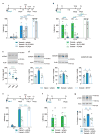Infantile amnesia reflects a developmental critical period for hippocampal learning
- PMID: 27428652
- PMCID: PMC5003643
- DOI: 10.1038/nn.4348
Infantile amnesia reflects a developmental critical period for hippocampal learning
Erratum in
-
Erratum: Infantile amnesia reflects a developmental critical period for hippocampal learning.Nat Neurosci. 2017 Jun 27;20(7):1033. doi: 10.1038/nn0717-1033a. Nat Neurosci. 2017. PMID: 28653686 No abstract available.
Abstract
Episodic memories formed during the first postnatal period are rapidly forgotten, a phenomenon known as 'infantile amnesia'. In spite of this memory loss, early experiences influence adult behavior, raising the question of which mechanisms underlie infantile memories and amnesia. Here we show that in rats an experience learned during the infantile amnesia period is stored as a latent memory trace for a long time; indeed, a later reminder reinstates a robust, context-specific and long-lasting memory. The formation and storage of this latent memory requires the hippocampus, follows a sharp temporal boundary and occurs through mechanisms typical of developmental critical periods, including the expression switch of the NMDA receptor subunits from 2B to 2A, which is dependent on brain-derived neurotrophic factor (BDNF) and metabotropic glutamate receptor 5 (mGluR5). Activating BDNF or mGluR5 after training rescues the infantile amnesia. Thus, early episodic memories are not lost but remain stored long term. These data suggest that the hippocampus undergoes a developmental critical period to become functionally competent.
Conflict of interest statement
The authors declare no competing financial interests.
Figures






Comment in
-
The hippocampus grows up.Nat Neurosci. 2016 Aug 26;19(9):1190-1. doi: 10.1038/nn.4368. Nat Neurosci. 2016. PMID: 27571198 No abstract available.
Similar articles
-
Hippocampal parvalbumin interneurons play a critical role in memory development.Cell Rep. 2022 Nov 15;41(7):111643. doi: 10.1016/j.celrep.2022.111643. Cell Rep. 2022. PMID: 36384113 Free PMC article.
-
Mechanisms of critical period in the hippocampus underlie object location learning and memory in infant rats.Learn Mem. 2018 Mar 15;25(4):176-182. doi: 10.1101/lm.046946.117. Print 2018 Apr. Learn Mem. 2018. PMID: 29545389 Free PMC article.
-
Infantile Amnesia: A Critical Period of Learning to Learn and Remember.J Neurosci. 2017 Jun 14;37(24):5783-5795. doi: 10.1523/JNEUROSCI.0324-17.2017. J Neurosci. 2017. PMID: 28615475 Free PMC article. Review.
-
Effects of sex and chronic neonatal nicotine treatment on Na²⁺/K⁺/Cl⁻ co-transporter 1, K⁺/Cl⁻ co-transporter 2, brain-derived neurotrophic factor, NMDA receptor subunit 2A and NMDA receptor subunit 2B mRNA expression in the postnatal rat hippocampus.Neuroscience. 2012 Dec 6;225:105-17. doi: 10.1016/j.neuroscience.2012.09.002. Epub 2012 Sep 12. Neuroscience. 2012. PMID: 22982626 Free PMC article.
-
The ontogeny of memory persistence and specificity.Dev Cogn Neurosci. 2019 Apr;36:100591. doi: 10.1016/j.dcn.2018.09.002. Epub 2018 Sep 29. Dev Cogn Neurosci. 2019. PMID: 30316637 Free PMC article. Review.
Cited by
-
Hippocampal parvalbumin interneurons play a critical role in memory development.Cell Rep. 2022 Nov 15;41(7):111643. doi: 10.1016/j.celrep.2022.111643. Cell Rep. 2022. PMID: 36384113 Free PMC article.
-
Disruption of hippocampal rhythms via optogenetic stimulation during the critical period for memory development impairs spatial cognition.Brain Stimul. 2020 Nov-Dec;13(6):1535-1547. doi: 10.1016/j.brs.2020.08.011. Epub 2020 Aug 29. Brain Stimul. 2020. PMID: 32871261 Free PMC article.
-
The role of motor memory dynamics in structuring bodily self-consciousness.iScience. 2021 Nov 26;24(12):103511. doi: 10.1016/j.isci.2021.103511. eCollection 2021 Dec 17. iScience. 2021. PMID: 34934929 Free PMC article.
-
Postnatal Development of Synaptic Plasticity at Hippocampal CA1 Synapses: Correlation of Learning Performance with Pathway-Specific Plasticity.Brain Sci. 2024 Apr 14;14(4):382. doi: 10.3390/brainsci14040382. Brain Sci. 2024. PMID: 38672030 Free PMC article.
-
Differential involvement of the medial prefrontal cortex across variants of contextual fear conditioning.Learn Mem. 2017 Jul 17;24(8):322-330. doi: 10.1101/lm.045286.117. Print 2017 Aug. Learn Mem. 2017. PMID: 28716952 Free PMC article.
References
-
- Campbell BA, Spear NE. Ontogeny of memory. Psychol Rev. 1972;79:215–236. - PubMed
-
- Hayne H. Infant memory development: Implications for childhood amnesia. Dev Rev. 2004;24:33–73.
-
- Rovee-Collier C. The development of infant memory. Curr Dir Psychol Sci. 1999;8:80–85.
-
- Heim C, Nemeroff CB. The role of childhood trauma in the neurobiology of mood and anxiety disorders: preclinical and clinical studies. Biol Psychiatry. 2001;49:1023–1039. - PubMed
-
- Dumas TC, Rudy JW. Development of the hippocampal memory system: Creating networks and modifiable synapses. In: Blumberg MS, Freeman JH, Robinson SR, editors. Oxford Handbook of Developmental Behavioral Neuroscience Oxford library of neuroscience. New York, NY, US: Oxford University Press; 2010.
Publication types
MeSH terms
Substances
Grants and funding
LinkOut - more resources
Full Text Sources
Other Literature Sources
Medical

